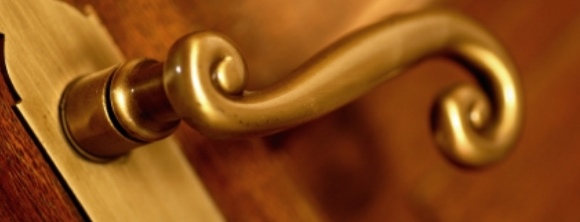Door Hardware

Door Hardware refers to any of the items that are attached to a door to enhance its functionality or appearance.
- Closer
- Hinges
- Handles
- Locks
- Fasteners
- Accessories
A door closer is a mechanical device that closes a door that is open.
A hinge is a component that attaches one edge of a door to the frame, while allowing the other edge to swing from it. It usually consists of a pair of plates, each with a set of open cylindrical rings (the knuckles) attached to them. The knuckles of the two plates are offset from each other and mesh together. A hinge pin is then placed through the two sets of knuckles and usually fixed, to combine the plates and make the hinge a single unit. One door usually has about three hinges, but it can vary.
Doors generally have at least one fixed handle, usually accompanied with a latch (see below). A typical “handle set” is composed of the exterior handle, escutcheon, an independent deadbolt, and the interior package (knob or lever). On some doors the latch is incorporated into a hinged handle that releases when pulled on.
Doorknob – A knob or lever on an axle that is rotated to release the bolt.
A lock is a device that prevents access by those without a key or combination, generally by preventing one or more latches from being operated. Often accompanied by an escutcheon. Some doors, particularly older ones, will have a keyhole accompanying the lock.
Most doors make use of one or more fasteners to hold the door closed. Typical or common fasteners include:
Latch – A device that allows one to fasten a door, but doesn’t necessarily require an external handle
Bolt – A (nearly always) metal shaft usually internal to the door, attached by cleats or a specific form of bracket, that slides into the jamb to fasten a door.
Latchbolt – A bolt that has an angled surface which acts as a ramp to push the bolt in while the door is being closed. By the use of a latchbolt, a door can be closed without having to operate the handle.
Deadbolt – Deadbolts usually extend deeper into the frame and are not automatically retractable the way latchbolts are. They are typically manipulated with a lock on the outside and either a lock or a latch on the inside. Deadbolts are generally used for security purposes on external doors in case somebody tries to kick the door in or use a tool such as a crowbar or a hammer and screwdriver etc.
Strike plate – A plate with a hole in the middle made to receive a bolt. If the strike is for a latchbolt, it typically also includes a small ramped area to help the bolt move inward while the door is being closed. (Also known as just “strike”) It’s also available as electric strike which allows you to open the door even though the mechanical lock is locked.
Numerous devices exist to serve specific purposes related to how a door should (or should not) be used:
Door closer – A device that closes an open door
Door damper – A hydraulic device employed to slow the door’s closure
Door knocker
Door stop – used to prevent the door from opening too far or striking another object
Espagnolette (for a window)
Fingerplate
Letter box or mail slot
Peephole
A number of items normally accompany doors but are not necessarily mounted on the door itself, such as doorbells.
The Main Types of Door Mechanisms
- Hinged Doors
- Sliding Doors
- Rotating Doors
- Others
Most doors are hinged along one side to allow the door to pivot away from the doorway in one direction but not in the other. The axis of rotation is usually vertical. In some cases, such as hinged garage doors, the axis may be horizontal, above the door opening.
Doors can be hinged so that the axis of rotation is not in the plane of the door to reduce the space required on the side to which the door opens. This requires a mechanism so that the axis of rotation is on the side other than that in which the door opens. This is sometimes the case in trains, such as for the door to the toilet, which opens inward.
A swing door has special hinges that allow it to open either outwards or inwards, and is usually sprung to keep it closed.
A selfbolting door is called as such because of its special hinges that permit the panel leaf to move laterally so that the door itself becomes a giant bolt for better security result. The selfbolting door principle can be used both for hinged doors as for rotating doors, as well as up-and-over doors (in the latter case, the bolts are then placed at top and bottom rather than at the sides).
French doors are derived from an original French design called the casement door. It is basically a double-leaved door with large glass panels in each door leaf, and in which the doors can swing both out as well as in. French doors traditionally have a moulded panel at the bottom of the door.
Dutch door or stable door; the top half of the door operates independently from the bottom half.
Garden door Similar to a French door; the hinge is next to the adjacent fixed door and the latch is located at the wall opening jamb. Typically only one door is operable. More secure than the French door.
It is often useful to have doors which slide along tracks, often for space or aesthetic considerations.
A bypass door is a door unit that has two or more sections. The doors can slide in either direction along one axis on parallel overhead tracks, sliding past each other. They are most commonly used in closets, in order to access one side of the closet at a time. The doors in a bypass unit will overlap slightly when viewed from the front, in order not to have a visible gap between them.
Doors which slide between two wall panels are called pocket doors.
Sliding glass doors are common in many houses, particularly as an entrance to the backyard. Such doors are also popular for use for the entrances to commercial structures.
A revolving door normally has four wings/leaves that hang on a center shaft and rotate one way about a vertical axis. The door may be motorized, or pushed manually using pushbars. People can walk out of and into the building at the same time. Between the point of access and the point of exit the user walks through an airlock. Revolving doors therefore create a good seal from the outside and help to reduce A/C and heating costs climate control from the building. This type of door is also often seen as a mark of prestige and glamour for a building and it not unusual for neighbouring buildings to install their own revolving doors when a rival building gets one.
A butterfly door called because of its two “wings”. It consists of a double-wide panel with its rotation axle in the centre, effectively creating two separate openings when the door is opened. Butterfly doors are made to rotate open in one direction (usually counterclockwise), and rotate closed in the opposite direction. The door is not equipped with handles, so it is a “push” door. This is for safety, because if it could open in both directions, someone approaching the door might be caught off-guard by someone else opening the other side, thus impacting the first person. Such doors are popular in public transit stations, as it has a large capacity, and when the door is opened, traffic passing in both directions keeps the door open. They are particularly popular in underground subway stations, because they are heavy, and when air currents are created by the movement of trains, the force will be applied to both wings of the door, thus equalizing the force on either side, keeping the door shut.
A up-and-over door mechanism with counterweight
Up-and-over or overhead doors are often used in garages. Instead of hinges it has a mechanism, often counterbalanced or sprung, that allows it to be lifted so that it rests horizontally above the opening. A roller shutter or sectional overhead door is one variant of this type.
A tambour door is an up-and-over door made of narrow horizontal slats and “rolls” up and down by sliding along vertical tracks and is typically found in entertainment centres and cabinets.
Automatically opening doors are powered open and closed either by electricity, spring, or both. There are several methods by which an automatically opening door is activated:
A sensor detects traffic is approaching. Sensors for automatic doors are generally:
A pressure sensor – e.g., a floor mat which reacts to the pressure of someone standing on it.
An infrared curtain or beam which shines invisible light onto sensors; if someone or something blocks the beam the door is triggered open.
A motion sensor which uses low-power microwave radar for the same effect.
A remote sensor (e.g. based on infrared or radio waves) can be triggered by a portable remote control, or is installed inside a vehicle. These are popular for garage doors.
A switch is operated manually, perhaps after security checks. This can be a push button switch or a swipe card.
The act of pushing or pulling the door triggers the open and close cycle. These are also known as power-assisted doors.
In addition to activation sensors automatically opening doors are generally fitted with safety sensors. These are usually an infrared curtain or beam, but can be a pressure mat fitted on the swing side of the door. The purpose of the safety sensor is to prevent the door from colliding with an object in its path by stopping or slowing its motion.
Inward opening doors are doors that can only be opened (or forced open) from outside a building. Such doors pose a substantial fire risk to occupants of occupied buildings when they are locked. As such doors can only be forced open from the outside, building occupants would be prevented from escaping. In commercial and retail situations manufacturers have included in the design a mechanism that allows an inward opening door to be pushed open outwards in the event of an emergency (which is often a regulatory requirement). This is known as a ‘breakaway’ feature. Pushing the door outward at its closed position, through a switch mechanism, disconnects power to the latch and allows the door to swing outward. Upon returning the door to the closed position, power is restored.
Rebated doors, a term chiefly used in Britain, are double doors having a lip (i.e. a Rabbet) on the vertical edge where they meet.




 Looking for pricing or additional information on our Replacement Window and/or Door Installation, Siding, Dry Rot Repair or other remodeling and construction services? Please call us right now or fill out the form.
Looking for pricing or additional information on our Replacement Window and/or Door Installation, Siding, Dry Rot Repair or other remodeling and construction services? Please call us right now or fill out the form. "We want to say Thank You so much for the windows and for the work it took to install them..."
"We want to say Thank You so much for the windows and for the work it took to install them..." 